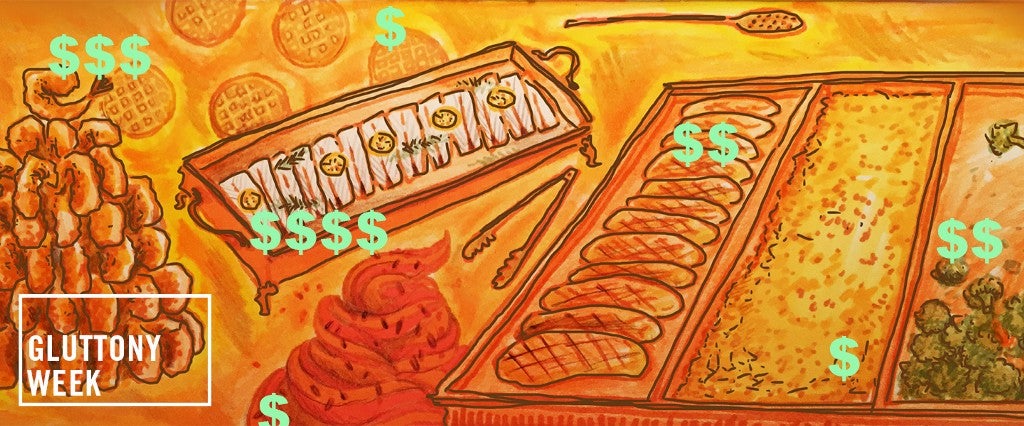“All you can eat” is more than just a business model for buffets — it’s a dream, a utopia, the promise of the infinite plenty of the cornucopia, rolled up into four magic words. At a buffet, the bowls aren’t just big; they’re bottomless. The refills aren’t just free; they’re unlimited. Among the steam tables and stacks of clean plates, we get to eat like kings. Or pigs.
There’s just so much food. But once you’ve packed away four plates of cornbread dressing, sweet-and-sour pork, Belgian waffles and shrimp cocktail (plus that piece of pecan pie topped with gummy bears and a cake pop), and you start looking at the logistics of the whole operation, two main questions arise:
- When the buffet closes, how much of that food gets tossed in the trash?
- And when does a buffet decide to send out a whole new tray of tilapia that no one’s going to eat, rather than let the dream of infinite food die?
Fortunately, a groundbreaking new paper in the field of buffetology has some answers. In short, per Ron McGarvey, a professor at the University of Missouri: A staggering amount of waste is built into the buffet business, and you always, always send out the tilapia.
To break down the economics behind buffets, McGarvey used the Mizzou dining halls as a case study. What he found was that chefs running all-you-can-eat operations will almost always choose to overproduce than run the risk of not having enough food — to a seemingly insane degree. “People rush out a full tray of eggs five minutes before closing time, because they feel like they need to maintain this ‘appearance of plenty,’” McGarvey explains.
In a normal restaurant, chefs and managers can pretty easily calculate how much money they’re losing if they run out of a certain dish — i.e., they know how much profit they make on each plate of beef ravioli, so they know what they’re missing out on if they have to cross it off the menu.
But the magic of buffets defies simple economics. Because the customer pays up front, the chefs just have to make a judgment call on how serious they were about their all-you-can-eat promise, take a guess on how much food their customers might eat and estimate how bad it would be for business if the social contract of endless everything was broken.
In an attempt to determine how much money Mizzou was spending (and the amount of food it was trashing) to keep up its appearance of a plentiful buffet bounty, McGarvey took data from the Mizzou dining hall’s inventory system and combined it with interviews with the chefs. “We saw that the valuation on shortfalls was huge,” McGarvey says. “Way, way larger than the cost of procuring the food or the cost of disposing of the food.”
In other words, the chefs were operating as if running out of beef ravioli or French fries cost them up to three times what the ravioli or fries cost in the first place. The logic of all-you-can-eat meant that buying three whole extra trays of tilapia, even if they ended up in the trash, was worth it to avoid having to say, “Sorry, we’re out.”
And that math isn’t limited to college dining halls. McGarvey has been doing preliminary work with an international hotel chain (he wouldn’t share the name), and sees the same thing happening with its breakfast buffets. “It’s surprising to see just how much they think they’re losing by running out of pancakes.”
He hasn’t yet worked with the big buffet chains, but even Ovation, the company that owns both HomeTown and Old Country Buffet, has said that dumping food in the trash is just part of the buffet business. “Every item will have anywhere from 5 to 25 percent waste, even with the small pans,” a senior Ovation administrator told Lucky Peach in 2014. “Whenever you’re doing more than one serving, you’re going to have waste.”
They try their best to curtail the waste by tracking how much people eat each week to refine their predictive models, and by using smaller portion sizes so their chefs don’t have to bring out a full tray of Salisbury steak just to keep up appearances.
The point of all this research, besides the appeal of putting numbers to something that was previously unknown, is to make sure chefs and managers really understand the decisions they’re making. For instance, in the second part of his paper, McGarvey went on to calculate the carbon footprint of three different dishes — beef ravioli, chicken sandwiches and french fries — to see how much more the wasted food was actually costing the world.
“If you start thinking of the environmental impacts of this,” McGarvey says, “not only should your overproduction shrink across the board, but meat and animal-based food should take the biggest hit.”
Not a bad calculation to make when you’re planning the menu for Thanksgiving, a holiday practically built on the “appearance of plenty.” Or better put, if you still feel like you really need that 20-pound turkey for your 10-person spread, consider serving carbon credits on the side.
